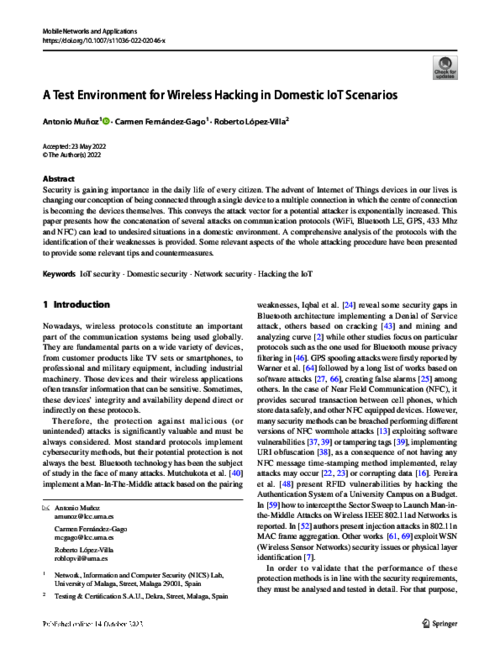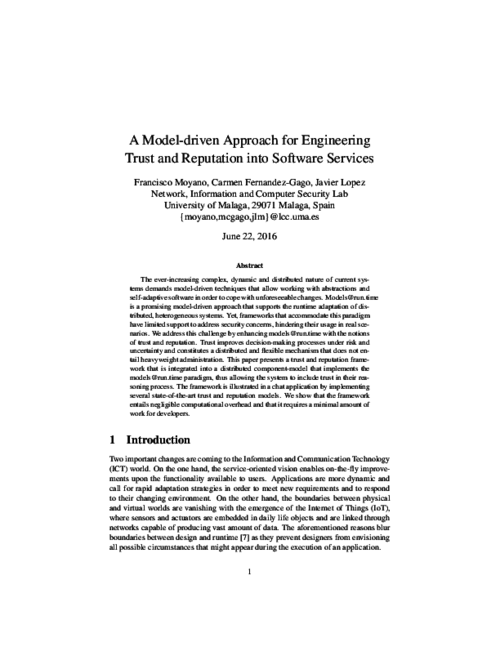 ] Type Year
] Type Year 36th Annual IFIP WG 11.3 Conference on Data and Applications Security and Privacy (DBSec'22), vol. 13383, Springer, pp. 183-194, 07/2022. DOI
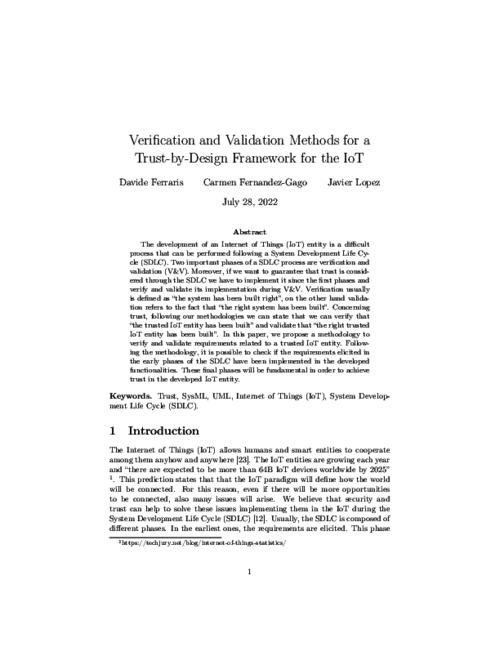
11th International Symposium on Temporal Representation and Reasoning (TIME’04), IEEE Computer Society, pp. 148-151, 2004. DOI
Abstract
Temporal logics of knowledge are useful for reasoning about situations where the knowledge of an agent or component is important, and where change in this knowledge may occur over time. Here we use temporal logics of knowledge to reason about security protocols. We show how to specify part of the Needham-Schroeder protocol using temporal logics of knowledge and prove various properties using a clausal resolution calculus for this logic.

2018 9th IFIP International Conference on New Technologies Mobility and Security (NTMS), IEEE, 04/2018. DOI
Abstract
The Internet of Things (IoT) is an environment of interconnected entities, that are identifiable, usable and controllable via the Internet. Trust is necessary in a system such as IoT as the entities involved should know the effect of interacting with other entities. Moreover, the entities must also be able to trust a system to reliably use it. An IoT system is composed of different entities from different vendors, each of them with a different purpose and a different lifecycle. So considering trust in the whole IoT system lifecycle is useful and necessary to guarantee a good service for the whole system. The heterogeneity and dynamicity of this field make it difficult to ensure trust in IoT. We propose a trust by design framework for including trust in the development of an IoT entity considering all the phases of the life-cycle. It is composed of the K-Model and transversal activities.
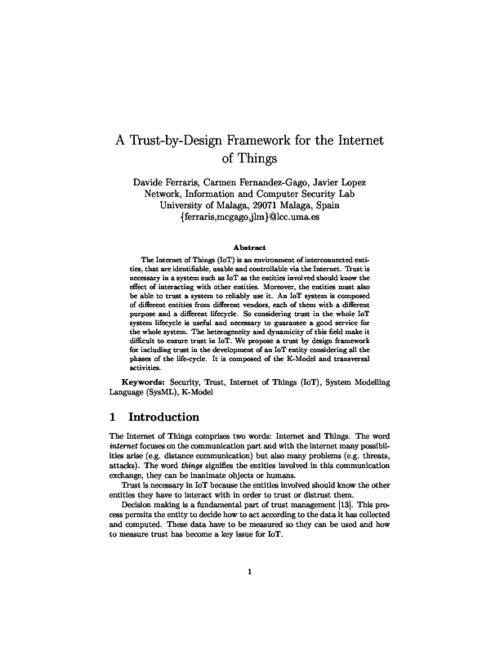
26th International Conference on Advanced Information Systems Engineering (CAiSE 2014), M. Jarke, et al. Eds., LCNS 8484, Springer, pp. 136-149, 06/2014. DOI
Abstract
Cloud sourcing consists of outsourcing data, services and infrastructure to cloud providers. Even when this outsourcing model brings advantages to cloud customers, new threats also arise as sensitive data and critical IT services are beyond customers' control. When an organization considers moving to the cloud, IT decision makers must select a cloud provider and must decide which parts of the organization will be outsourced and to which extent. This paper proposes a methodology that allows decision makers to evaluate their trust in cloud providers. The methodology provides a systematic way to elicit knowledge about cloud providers, quantify their trust factors and aggregate them into trust values that can assist the decision-making process. The trust model that we propose is based on trust intervals, which allow capturing uncertainty during the evaluation, and we define an operator for aggregating these trust intervals. The methodology is applied to an eHealth scenario.
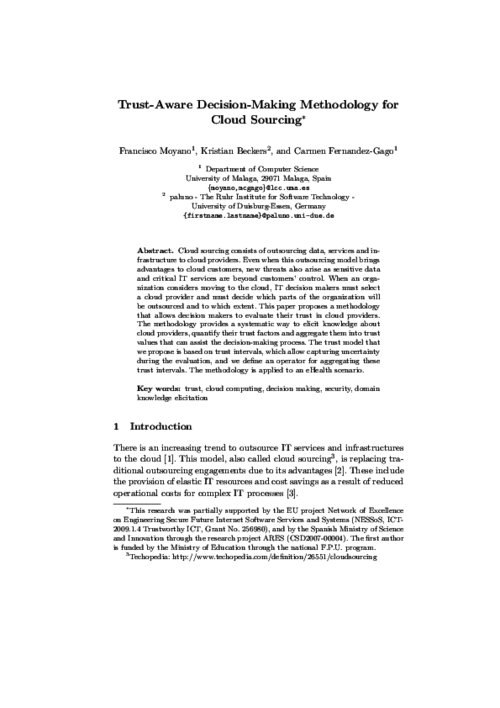
International Journal of Information Security , Springer, pp. 111-127, 01/2020, 2019. DOI
Abstract
The Internet of Things (IoT) is an environment of interconnected entities, which are identifiable, usable and controllable via the Internet. Trust is useful for a system such as the IoT as the entities involved would like to know how the other entities they have to interact with are going to perform.
When developing an IoT entity, it will be desirable to guarantee trust during its whole life cycle. Trust domain is strongly dependent on other domains such as security and privacy.
To consider these domains as a whole and to elicit the right requirements since the first phases of the System Development Life Cycle (SDLC) is a key point when developing an IoT entity.
This paper presents a requirements elicitation method focusing on trust plus other domains such as security, privacy and usability that increase the trust level of the IoT entity developed. To help the developers to elicit the requirements, we propose a JavaScript Notation Object (JSON) template containing all the key elements that must be taken into consideration.
We emphasize on the importance of the concept of traceability. This property permits to connect all the elicited requirements guaranteeing more control on the whole requirements engineering process.
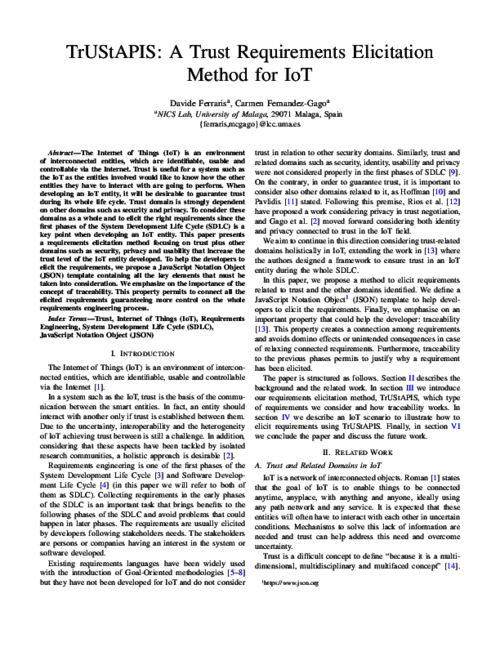
International Journal of Information Security, Springer, 2020. DOI
Abstract
Nowadays, smart home devices like Amazon Echo and Google Home have reached mainstream popularity.
Being in the homes of users, these devices are intrinsically intrusive, being able to access details such as users' name, gender, home address, calendar appointments and others.
There are growing concerns about indiscriminate data collection and invasion of user privacy in smart home devices, but studies show that perceived benefits are exceeding perceived risks when it comes to consumers.
As a result, consumers are placing a lot of trust in these devices, sometimes without realizing it.
Improper trust assumptions and security controls can lead to unauthorized access and control of the devices, which can result in serious consequences.
In this paper, we explore the behaviour of devices such as Amazon Echo and Google Home in a smart home setting with respect to trust relationships and propose a trust model to improve these relationships among all the involved actors.
We have evaluated how trust was built and managed from the initial set up phase to the normal operation phase, during which we performed a number of interaction tests with different types of users (i.e. owner, guests).
As a result, we were able to assess the effectiveness of the provided security controls and identify potential relevant security issues. In order to address the identified issues, we defined a trust model and propose a solution based on it for further securing smart home systems.
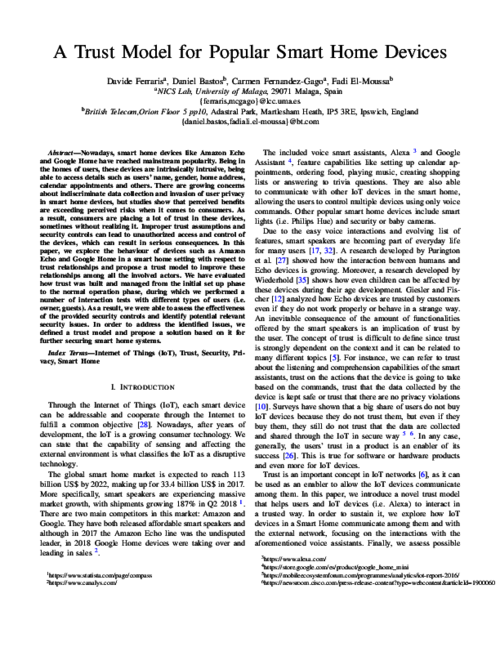
Trust Management VII, 7th WG11.11 International conference
, vol. 401, Springer, June 2013.
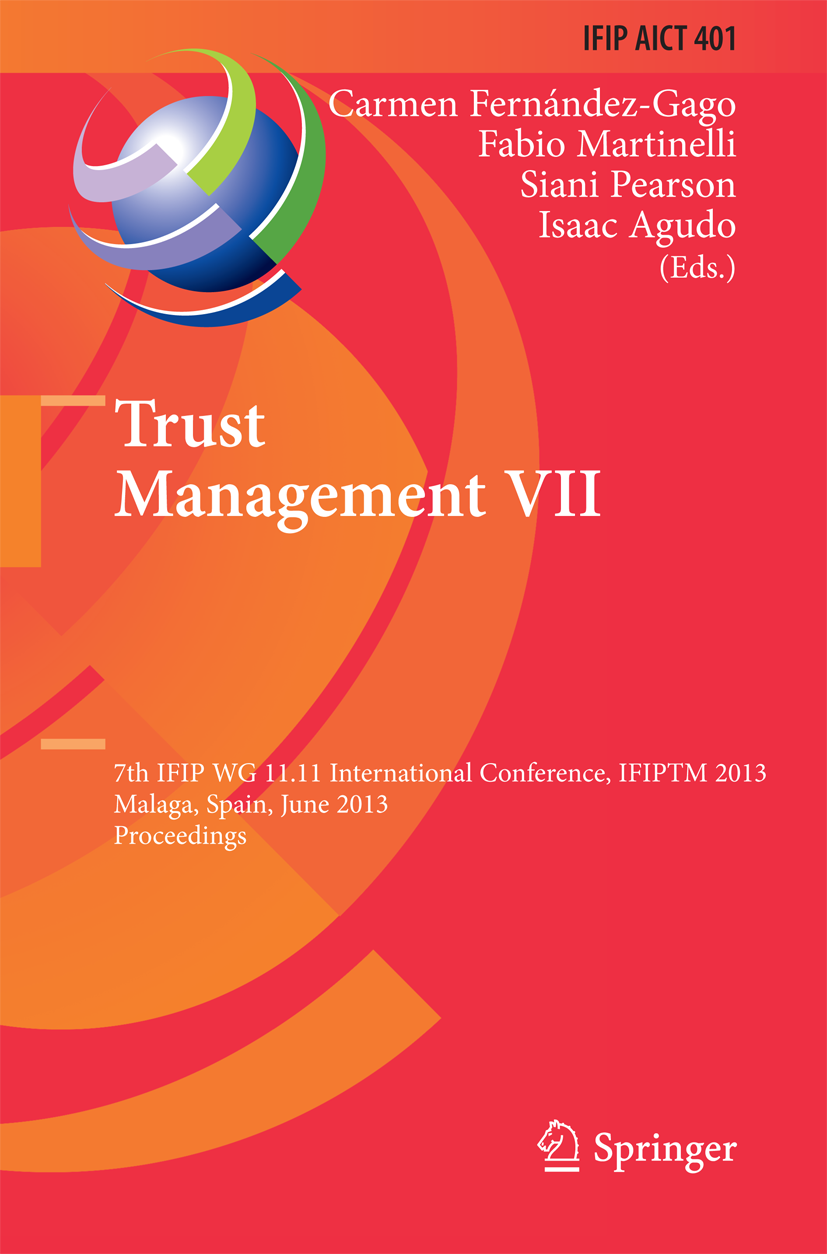 |  |
Computer Communications, vol. 33, no. 9, Elsevier, pp. 0140-3664, 2010. DOI
Abstract
Wireless sensor networks (WSNs) have been proven a useful technology for perceiving information about the physical world and as a consequence has been used in many applications such as measurement of temperature, radiation, flow of liquids, etc. The nature of this kind of technology, and also their vulnerabilities to attacks make the security tools required for them to be considered in a special way. The decision making in a WSN is essential for carrying out certain tasks as it aids sensors establish collaborations. In order to assist this process, trust management systems could play a relevant role. In this paper, we list the best practices that we consider are essential for developing a good trust management system for WSN and make an analysis of the state of the art related to these practices.
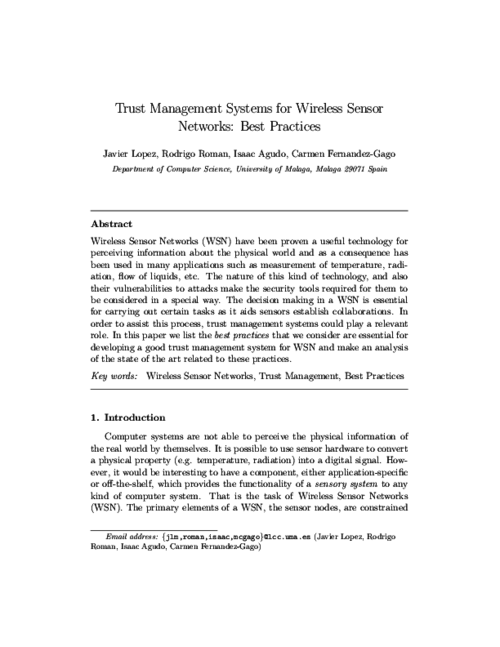
Security and Privacy in Mobile and Wireless Networking, S. Gritzalis, T. Karygiannis, and C. Skianis Eds., Troubador Publishing Ltd, pp. 105-128, 2009.
Abstract
The concept of trust has become very relevant in the late years as a consequence of the growth of fields such as internet transactions or electronic commerce. In general, trust has become of paramount importance for any kind of distributed networks, such as wireless sensor networks (WSN in the following). In this chapter of the book, we try to give a general overview of the state of the art on trust management systems for WSN and also try to identify the main features of the architectures of these trust management systems.
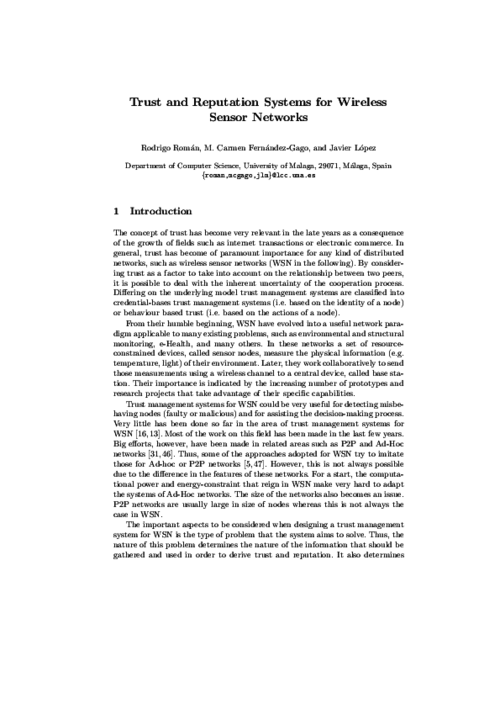
Doctoral Symposium of the International Symposium on Engineering Secure Software and Systems (ESSoS-DS 2013), M. Heisel, and E. Marchetti Eds., CEUR-WS 965, CEUR-WS, pp. 7-12, 2013.
Abstract
The Future Internet is posing new security challenges as their scenarios are bringing together a huge amount of stakeholders and devices that must interact under unforeseeable conditions. In addition, in these scenarios we cannot expect entities to know each other beforehand, and therefore, they must be involved in risky and uncertain collaborations. In order to minimize threats and security breaches, it is required that a well-informed decision-making process is in place, and it is here where trust and reputation can play a crucial role. Unfortunately, services and applications developers are often unarmed to address trust and reputation requirements in these scenarios. To overcome this limitation, we propose a trust and reputation framework that allows developers to create trust- and reputation-aware applications.
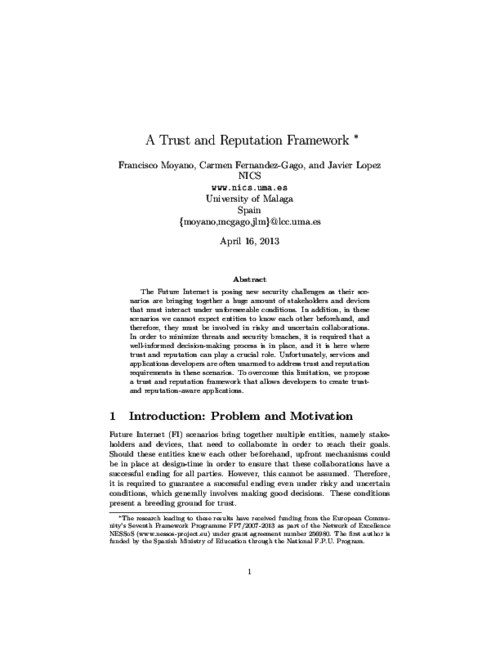
7th IFIP WG 11.11 International Conference on Trust Management (IFIPTM 2013), C. Fernandez-Gago, I. Agudo, F. Martinelli, and S. Pearson Eds., AICT 401, Springer, pp. 255-262, Jun 2013. DOI
Abstract
The Future Internet (FI) comprises scenarios where many heterogeneous and dynamic entities must interact to provide services (e.g., sensors, mobile devices and information systems in smart city scenarios). The dynamic conditions under which FI applications must execute call for self-adaptive software to cope with unforeseeable changes in the application environment. Software engineering currently provides frameworks to develop reasoning engines that automatically take reconfiguration decisions and that support the runtime adaptation of distributed, heterogeneous applications. However, these frameworks have very limited support to address security concerns of these application, hindering their usage for FI scenarios. We address this challenge by enhancing self-adaptive systems with the concepts of trust and reputation. Trust will improve decision-making processes under risk and uncertainty, in turn improving security of self-adaptive FI applications. This paper presents an approach that includes a trust and reputation framework into a platform for adaptive, distributed component-based systems, thus providing software components with new abilities to include trust in their reasoning process.
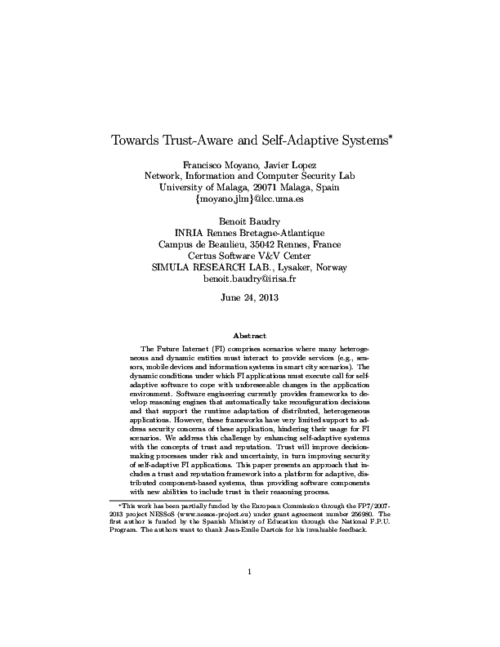
3rd International Workshop on Information Systems Security Engineering (WISSE 2013), X. Franch, and P. Soffer Eds., LNBIP 148, Springer-Verlag, pp. 490-501, Jun 2013. DOI
Abstract
Security must be a primary concern when engineering Future Internet (FI) systems and applications. In order to achieve secure solutions, we need to capture security requirements early in the Software Development Life Cycle (SDLC). Whereas the security community has traditionally focused on providing tools and mechanisms to capture and express hard security requirements (e.g. confidentiality), little attention has been paid to other important requirements such as trust and reputation. We argue that these soft security requirements can leverage security in open, distributed, heterogeneous systems and applications and that they must be included in an early phase as part of the development process. In this paper we propose a UML extension for specifying trust and reputation requirements, and we apply it to an eHealth case study.
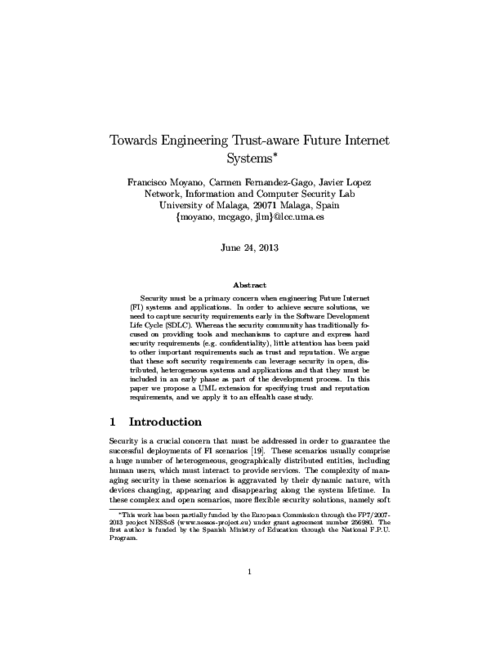
9th IFIP Summer School on Privacy and Identity Management for the Future Internet in the Age of Globalisation, vol. 457, Springer IFIP AICT, pp. 219-236, 2015. DOI
Abstract
Cloud computing is becoming a key IT infrastructure technology being adopted progressively by companies and users. Still, there are issues and uncertainties surrounding its adoption, such as security and how users data is dealt with that require attention from developers, researchers, providers and users. The A4Cloud project tries to help solving the problem of accountability in the cloud by providing tools that support the process of achieving accountability. This paper presents the contents of the first A4Cloud tutorial. These contents include basic concepts and tools developed within the project. In particular, we will review how metrics can aid the accountability process and some of the tools that the A4Cloud project will produce such as the Data Track Tool (DTT) and the Cloud Offering Advisory Tool (COAT).
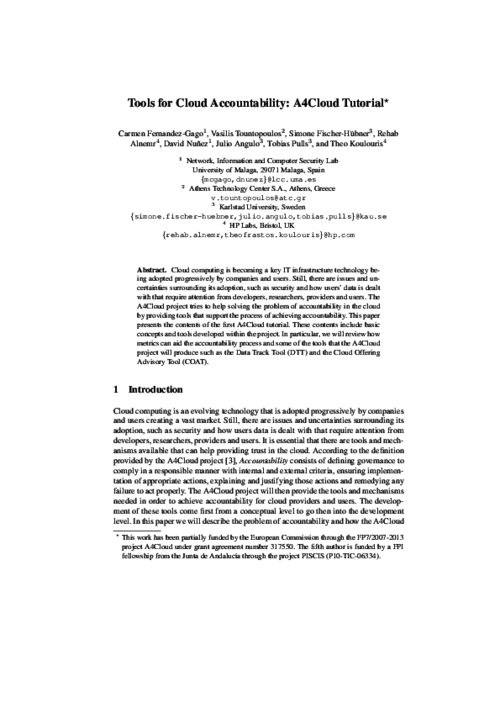
Mobile Networks and Applications, Springer, 2022/10/14. DOI
First Workshop in Information and Computer Security (ICS’06), vol. 186, Elsevier, pp. 27-42, 2007. DOI
Abstract
Temporal logics of knowledge are useful for reasoning about situations where the knowledge of an agent or component is important, and where change in this knowledge may occur over time. Here we investigate the application of temporal logics of knowledge to the specification and verification of security protocols. We show how typical assumptions relating to authentication protocols can be specified. We consider verification methods for these logics, in particular, focusing on proofs using clausal resolution. Finally we present experiences from using a resolution based theorem prover applied to security protocols specified in temporal logics of knowledge.
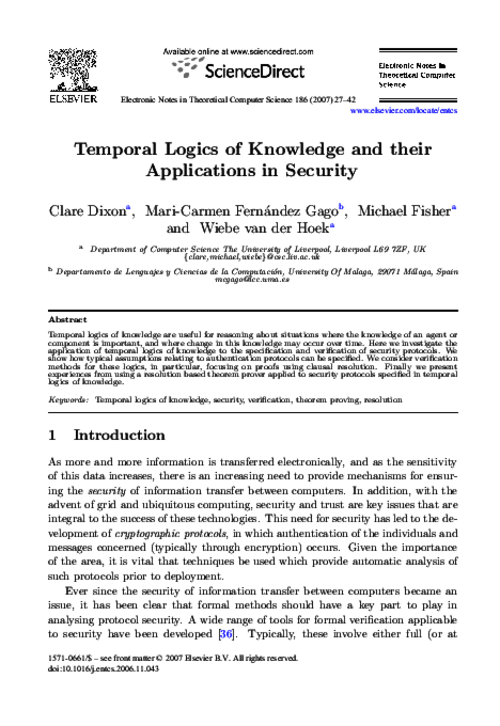
Proceedings of the 2012 International Symposium on Engineering Secure Software and Systems (ESSoS 2012), G. Barthe, B. Livshits, and R. Scandariato Eds., LNCS 7159, Springer, pp. 76–89, Feb 2012. DOI
Abstract
Trust has become essential in computer science as a way of assisting the process of decision-making, such as access control. In any system, several tasks may be performed, and each of these tasks might pose different associated trust values between the entities of the system. For instance, in a file system, reading and overwriting a file are two tasks that pose different trust values between the users who can carry out these tasks. In this paper, we propose a simple model for automatically establishing trust relationships between entities considering an established order among tasks.
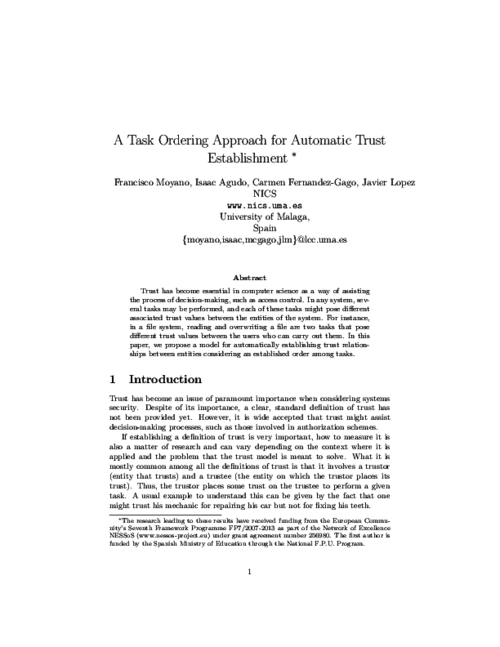
3rd International Workshop on Security, Privacy and Trust in Pervasive and Ubiquitous Computing (SecPerU’07), IEEE Computer Society, pp. 25-30, 2007. DOI
Abstract
Trust plays an important role in human life environments and virtual organizations. In the context of a network, trust may help its elements to decide whether another member of the same network is being uncooperative or malicious. Trust becomes quite important in self-configurable and autonomous systems, such as wireless sensor networks (WSN). However, very little effort has been done in the field of trust management in WSN. On the other hand, some efforts have been made in quite related fields such as Ad-hoc and P2P networks. In this paper we give an overview of existing trust management solutions, mainly those developed for Ad-Hoc and P2P networks and, more importantly, investigate their suitability to WSN. We also provide some guidelines to aid the development of trust management systems for WSN according to the nature of these networks.
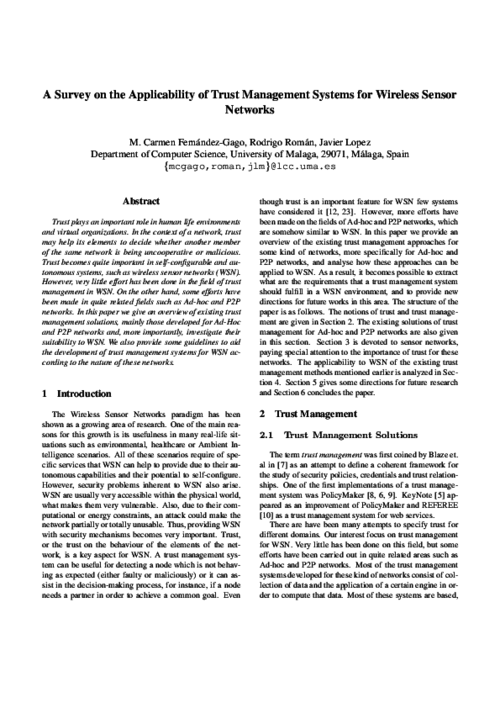
Journal of Information Security and Applications, vol. 61, no. 102916, Elsevier, 09/2021. DOI
First International Conference on Ambient Intelligence Developments (AmID’06), Springer, pp. 108-123, September, 2006. DOI
Abstract
The realization of the Ambient Intelligence concept entails many important challenges, but the most important barriers to this realization is the lack of adequate support for security. In this paper we present a conceptual model of our solution for building secure systems for AmI environments, taking as basis the concept of Security and Dependability (S&D) Pattern as a precise representation of validated S&D solutions and mechanisms. The main elements embedded in our solution framework (S&D library, monitoring interface and S&D Manager) are presented both conceptually, and also using a simple example scenario based on an hospital AmI environment.
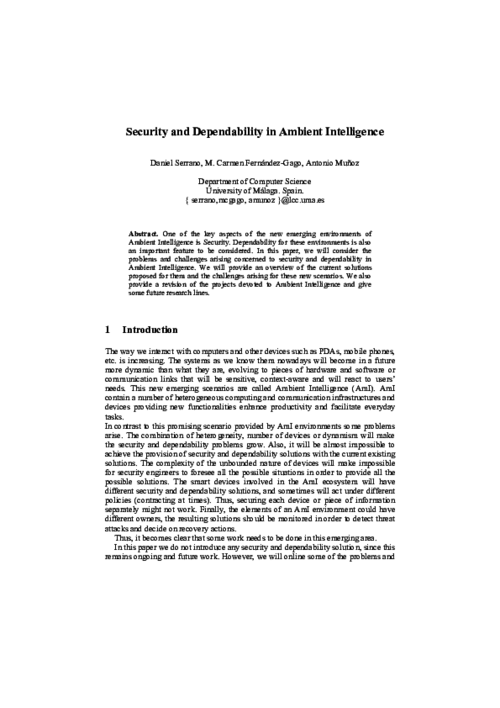
Proceedings of the Doctoral Symposium of the International Symposium on Engineering Secure Software and Systems (ESSoS-DS 2012), J. Cuellar, and N. Koch Eds., CEUR-WS 834, CEUR-WS, pp. 41-46, 2012.
Abstract
As the Future Internet arrives, more complex, service-based applications are spreading. These applications pose several challenges, including the huge amount of entities that must interact and their het- erogeneity. The success of these applications depends on the collaboration and communication of these entities, that might belong to different or- ganizations and administrative domains. Therefore, trust and reputation become two crucial issues. We propose the specification and design of a service-based security architecture that stresses the delivery of trust and reputation services to any application that might require them.
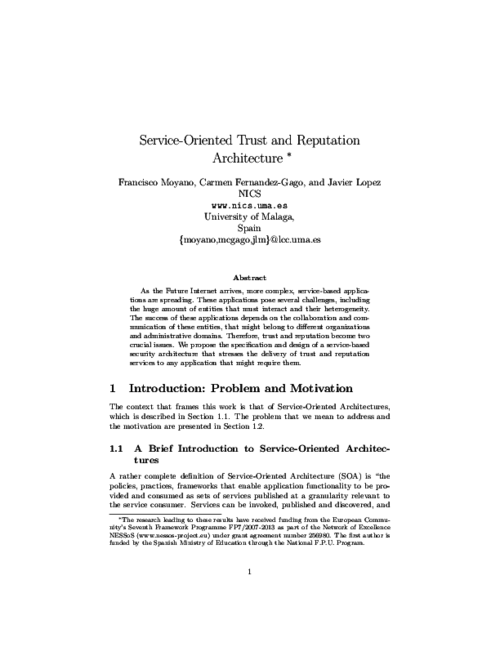
IEEE Consumer Communications & Networking Conference 2019, IEEE, 03/2019. DOI
Abstract
With the ever-increasing number of smart home devices, the issues related to these environments are also growing. With an ever-growing attack surface, there is no standard way to protect homes and their inhabitants from new threats. The inhabitants are rarely aware of the increased security threats that they are exposed to and how to manage them. To tackle this problem, we propose a solution based on segmented architectures similar to the ones used in industrial systems. In this approach, the smart home is segmented into various levels, which can broadly be categorised into an inner level and external level. The external level is protected by a firewall that checks the communication from/to the Internet to/from the external devices. The internal level is protected by an additional firewall that filters the information and the communications between the external and the internal devices. This segmentation guarantees a trusted environment between the entities belonging to the internal network. In this paper, we propose an adaptive trust model that checks the behaviour of the entities and, through this model, in case the entities violate trust rules they can be put in quarantine or banned from the network.
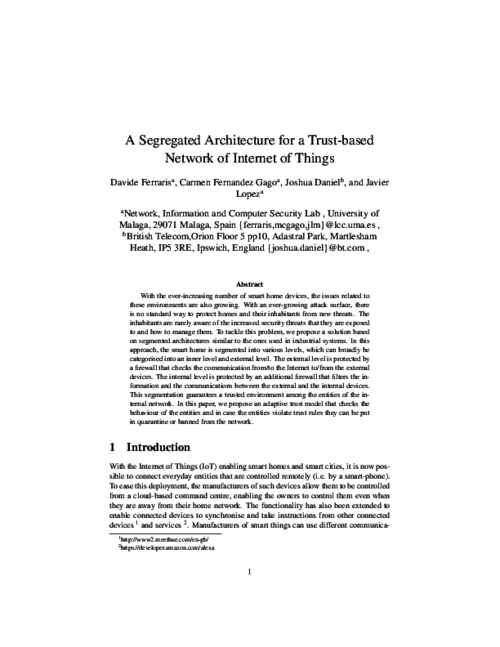
Computer Standards and Interfaces, vol. 32, no. 5-6, Elsevier, pp. 230-245, Oct 2010. DOI
Abstract
This paper describes the security framework that is to be developed for the generic grid platform created for the project GREDIA. This platform is composed of several components that need to be secured. The platform uses the OGSA standards, so that the security framework will follow GSI, the portion of Globus that implements security. Thus, we will show the security features that GSI already provides and we will outline which others need to be created or enhanced.
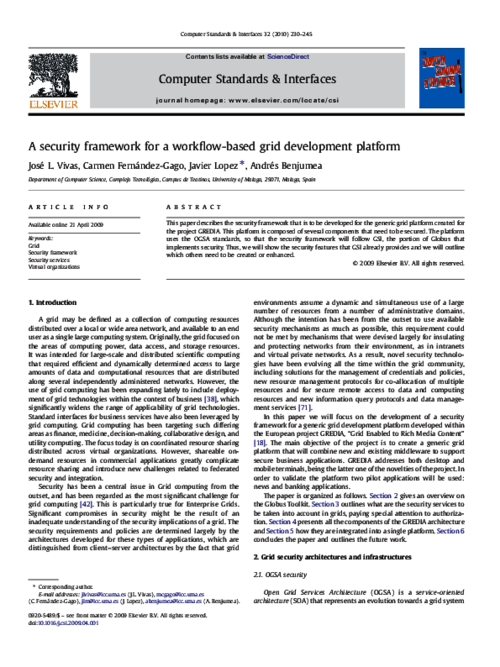
Security and Trust Management - 7th International Workshop, STM 2011
, vol. 7170, Springer, July 2012.
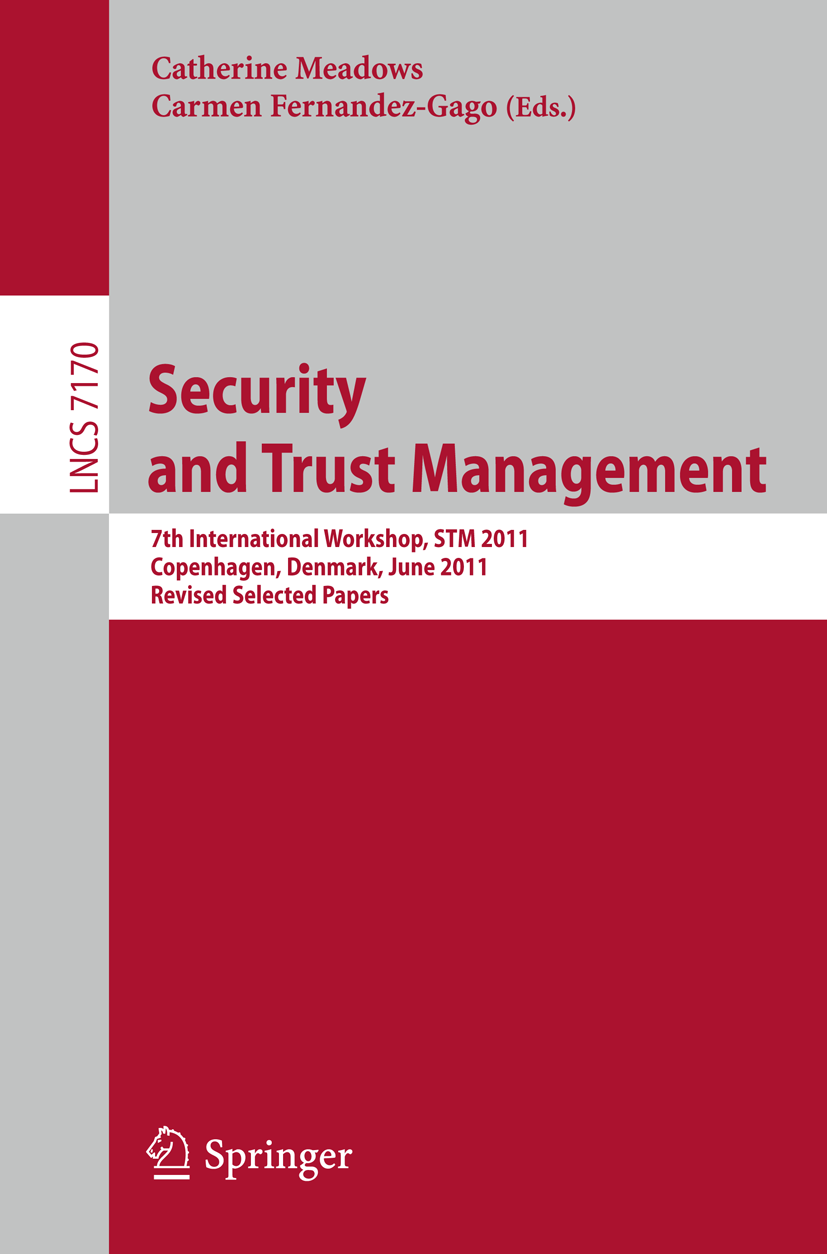 |  |
Computers and Mathematics with Applications, vol. 60, Elsevier, pp. 209-216, July, 2010. DOI
Abstract
When interactions among users of a system have to take place, for example, over the internet, establishing trust relationships among these users becomes crucial. However, the way this trust is established depends to a certain extent on the context where the interactions take place. Most of the time, trust is encoded as a numerical value that might not be very meaningful for a not very experienced user. In this paper we propose a model that takes into account the semantic and the computational sides of trust. This avoids users having to deal directly with the computational side; they instead deal with meaningful labels such as Bad or Good in a given context.
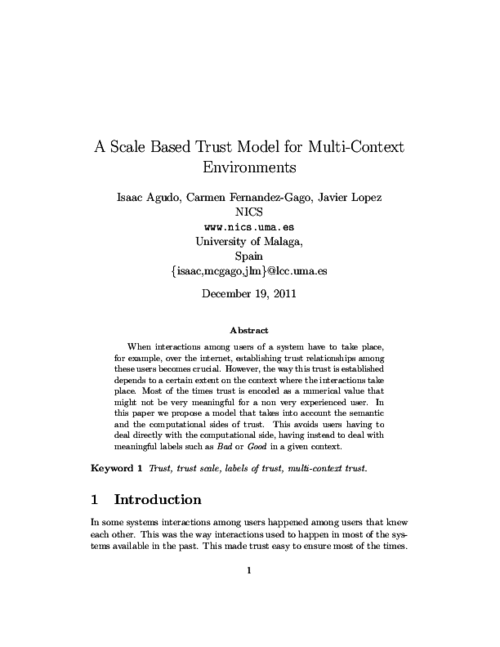
Accountability and Security in the Cloud, M. Felici, and C. Fernandez-Gago Eds., Lecture Notes in Computer Science 8937, Springer International Publishing, pp. 114-125, 2015. DOI
Abstract
In this paper we tackle the problem of privacy and confidentiality in Identity Management as a Service (IDaaS). The adoption of cloud computing technologies by organizations has fostered the externalization of the identity management processes, shaping the concept of Identity Management as a Service. However, as it has happened to other cloud-based services, the cloud poses serious risks to the users, since they lose the control over their data. As part of this work, we analyze these concerns and present a model for privacy-preserving IDaaS, called BlindIdM, which is designed to provide data privacy protection through the use of cryptographic safeguards.
12th International Workshop on Security and Trust Management (STM), vol. LNCS 9871, Springer, pp. 98-105, 09/2016. DOI
Abstract
Software engineering and information security have traditionally followed divergent paths but lately some efforts have been made to consider security from the early phases of the Software Development Life Cycle (SDLC). This paper follows this line and concentrates on the incorporation of trust negotiations during the requirements engineering phase. More precisely, we provide an extension to the SI* modelling language, which is further formalised using answer set programming specifications to support the automatic verification of the model and the detection of privacy conflicts caused by trust negotiations.
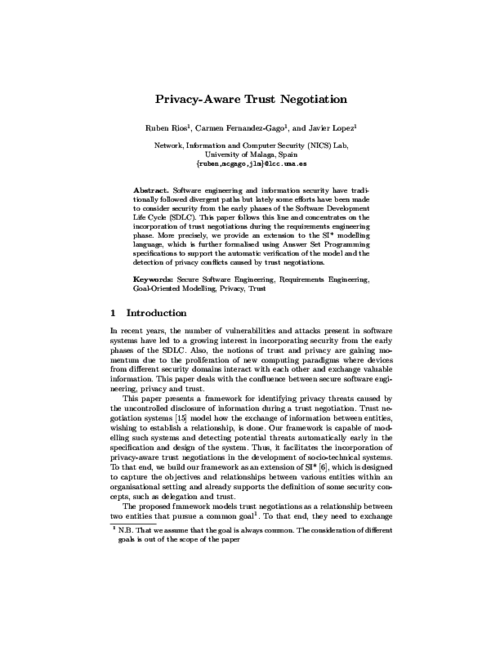
Collaborative Approaches for Cyber Security in Cyber-Physical Systems, no. Part of the Advanced Sciences and Technologies for Security Applications book series (ASTSA), Springer, pp. 145-170, 01/2023. DOI

32nd Annual IFIP WG 11.3 Conference on Data and Applications Security and Privacy XXXII, 2018, vol. 10980, Springer, Cham, pp. 69-84, 07/2018. DOI
Abstract
Entities, such as people, companies, institutions, authorities and web sites live and exist in a conjoined world. In order to live and enjoy social benefits, entities need to share knowledge, resources and to cooperate together. The cooperation brings with it many new challenges and problems, among which one is the problem of trust. This area is also important for the Computer Science. When unfamiliar entities wish to cooperate, they do not know what to expect nor whether they can trust each other. Trust negotiation solves this problem by sequential exchanging credentials between entities, which have decided to establish a trust relationship in order to reach a common goal. Entities specify their own policies that handle a disclosure of confidential information to maintain their security and privacy. Policies are defined by means of a policy language. This paper aims to identify the most suitable policy language for trust negotiation. To do so, policy languages are analysed against a set of criteria for trust negotiation that are first established.
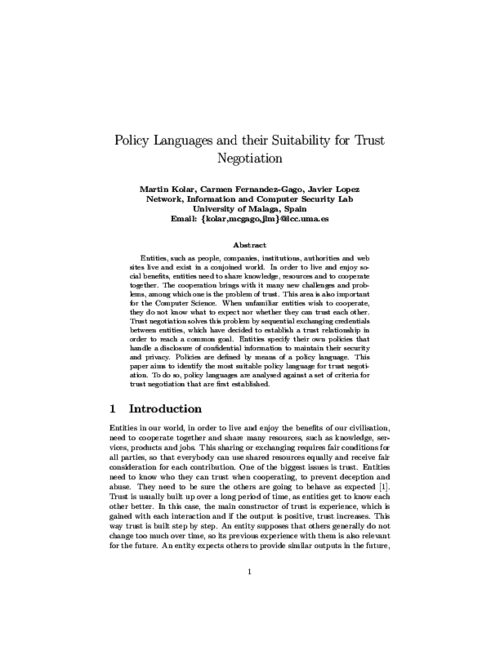
37th International Conference on ICT Systems Security and Privacy Protection – IFIP SEC 2022, Springer, pp. 215-230, 06/2022. DOI
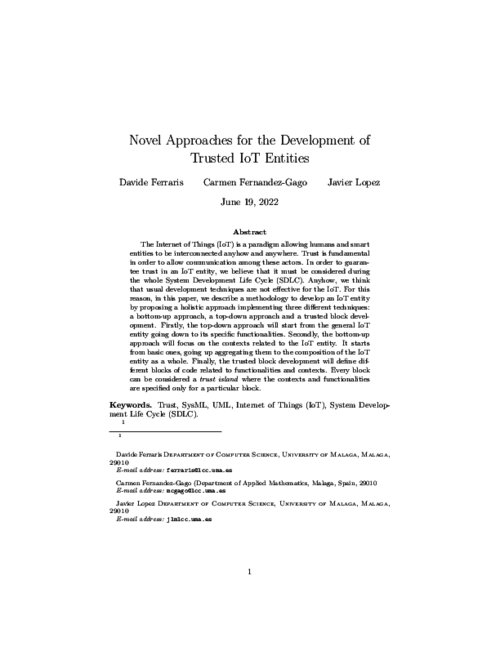
Sixth European Workshop on Public Key Services, Applications and Infrastructures (EuroPKI’09), LNCS 6391, Springer, pp. 225-238, 2009. DOI
Abstract
Deciding who to trust in the internet of services paradigm is an important and open question. How to do it in an optimal way is not always easy to determine. Trust is usually referred to a particular context whereas a single user may interact in more than one given context. We are interested in investigating how a Federated Reputation System can help exporting trust perceptions from one context to another. We propose a model for deriving trust in online services. In this context, trust is defined as the level of confidence that the service provider holds on the subject interacting with it to behave in a proper way while using the service. Thus, we derive trust by using the reputation values that those users have gained for interacting with these services.
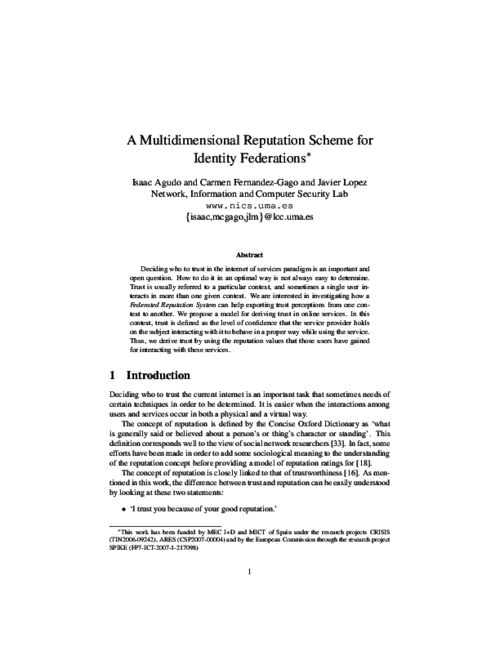
Information Sciences, vol. 396, Elsevier, pp. 72-82, 2017. DOI
Abstract
The Internet of Things (IoT) is a paradigm based on the interconnection of everyday objects. It is expected that the ‘things’ involved in the IoT paradigm will have to interact with each other, often in uncertain conditions. It is therefore of paramount importance for the success of IoT that there are mechanisms in place that help overcome the lack of certainty. Trust can help achieve this goal. In this paper, we introduce a framework that assists developers in including trust in IoT scenarios. This framework takes into account trust, privacy and identity requirements as well as other functional requirements derived from IoT scenarios to provide the different services that allow the inclusion of trust in the IoT.
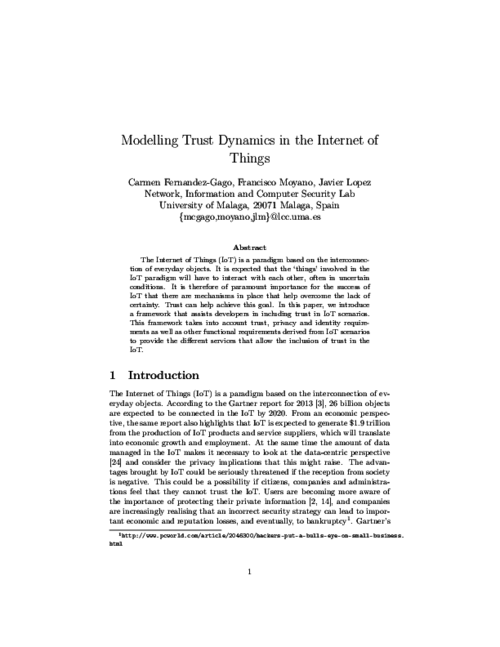
Computers & Security, vol. 77 , issue August 2018, Elsevier, pp. 773-789, 2018. DOI
Abstract
Trust negotiations are mechanisms that enable interaction between previously unknown users. After exchanging various pieces of potentially sensitive information, the participants of a negotiation can decide whether or not to trust one another. Therefore, trust negotiations bring about threats to personal privacy if not carefully considered. This paper presents a framework for representing trust negotiations in the early phases of the Software Development Life Cycle (SDLC). The framework can help software engineers to determine the most suitable policies for the system by detecting conflicts between privacy and trust requirements. More precisely, we extend the SI* modelling language and provide a set of predicates for defining trust and privacy policies and a set of rules for describing the dynamics of the system based on the established policies. The formal representation of the model facilitates its automatic verification. The framework has been validated in a distributed social network scenario for connecting drivers with potential passengers willing to share a journey.
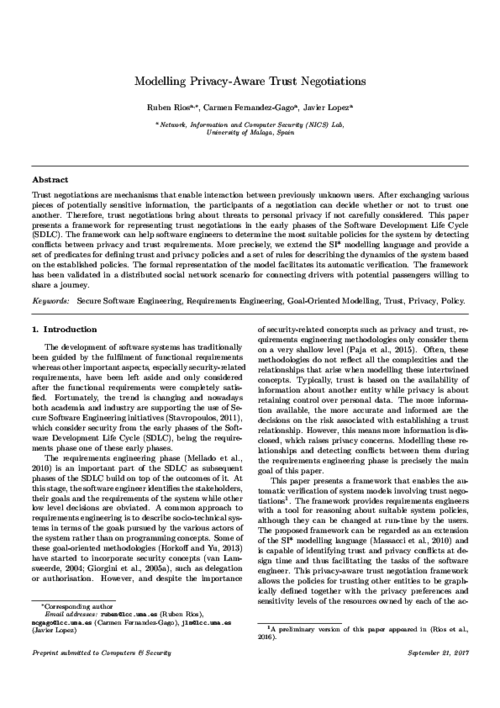
Human-centric Computing and Information Sciences, vol. 10, no. 50, Springer, 12/2020. DOI
Abstract
The Internet of Things (IoT) is a paradigm that permits smart entities to be interconnected anywhere and anyhow. IoT opens new opportunities but also rises new issues.
In this dynamic environment, trust is useful to mitigate these issues. In fact, it is important that the smart entities could know and trust the other smart entities in order to collaborate with them.
So far, there is a lack of research when considering trust through the whole System Development Life Cycle (SDLC) of a smart IoT entity.
In this paper, we suggest a new approach that considers trust not only at the end of the SDLC but also at the start of it. More precisely, we explore the modeling phase proposing a model-driven approach extending UML and SysML considering trust and its related domains, such as security and privacy.
We propose stereotypes for each diagram in order to give developers a way to represent trust elements in an effective way.
Moreover, we propose two new diagrams that are very important for the IoT: a traceability diagram and a context diagram.
This model-driven approach will help developers to model the smart IoT entities according to the requirements elicited in the previous phases of the SDLC.
These models will be a fundamental input for the following and final phases of the SDLC.
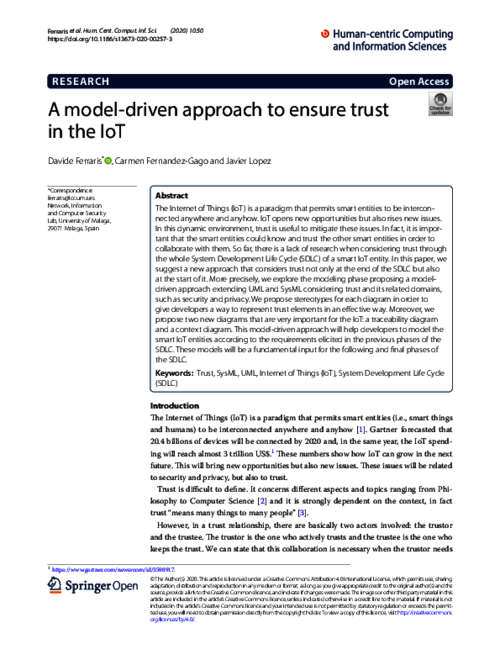
Journal of Network and Computer Applications, vol. 69, Elsevier, pp. 134-151, 04/2016.
The 14th International Conference on Network and System Security (NSS 2020), vol. 12570, Springer, pp. 327-341, 11/2020.
Abstract
Trust negotiation represents a suitable approach for building trust in online environments, where the interacting entities are anonymous. It covers important criteria on security and privacy. In this work, we propose a method for implementing our model specification that handles trust negotiation. We define the structure of the trust negotiation module that is a standalone unit capable of negotiating on its own. It may be included to any software by its defined interfaces. We realise our method with a ride-sharing scenario and four trust negotiation strategies that we apply in order to validate our design and implementation. We propose a solution that is fully customisable based on different requirements. The proposal provides guidelines for developers in the process of including trust negotiation into their software.
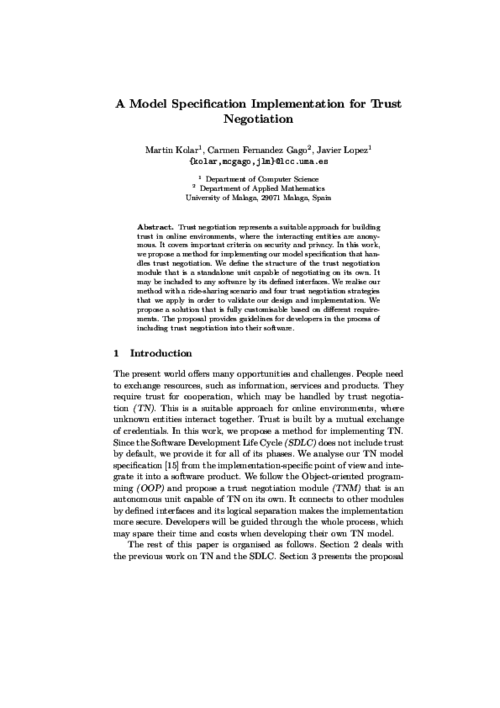
Computers & Security, vol. 84, issue July 2019, Elsevier, pp. 288-300, 04/2019. DOI
Abstract
Trust negotiation is a type of trust management model for establishing trust between entities by a mutual exchange of credentials. This approach was designed for online environments, where the attributes of users, such as skills, habits, behaviour and experience are unknown. Required criteria of trust negotiation must be supported by a trust negotiation model in order to provide a functional, adequately robust and efficient application. Such criteria were identified previously. In this paper we are presenting a model specification using a UML-based notation for the design of trust negotiation. This specification will become a part of the Software Development Life Cycle, which will provide developers a strong tool for incorporating trust and trust-related issues into the software they create. The specification defines components and their layout for the provision of the essential functionality of trust negotiation on one side as well as optional, additional features on the other side. The extra features make trust negotiation more robust, applicable for more scenarios and may provide a privacy protection functionality.
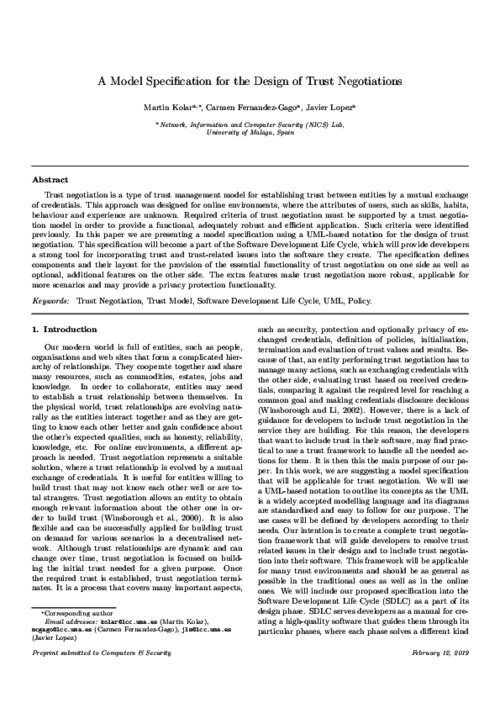
5th International Conference on Trust, Privacy and Security in Digital Business (TrustBus’08), LNCS 5185, Springer, pp. 28-37, 2008. DOI
Abstract
Trust is an important factor in any kind of network essential, for example, in the decision-making process. As important as the definition of trust is the way to compute it. In this paper we propose a model for defining trust based on graph theory and show examples of some simple operators and functions that will allow us to compute trust.
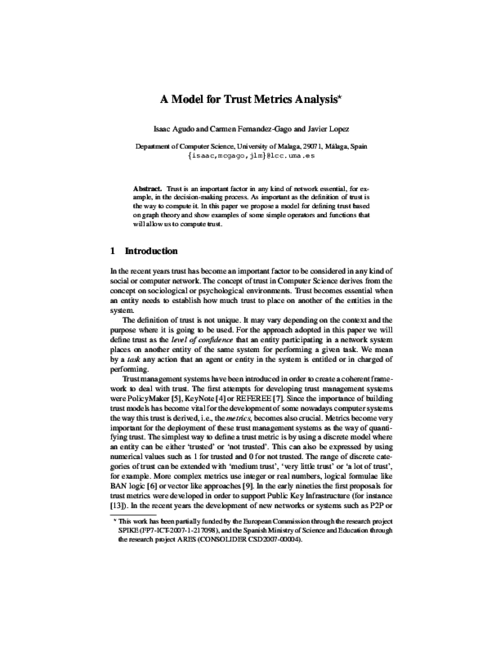
Accountability and Security in the Cloud, vol. 8937, no. LNCS Tutorial, pp. 129-153, 2015.
2013 IEEE International Conference on Cloud Computing Technology and Science (CloudCom 2013), IEEE, pp. 355-362, 12/2013. DOI
Abstract
Cloud governance, and in particular data governance in the cloud, relies on different technical and organizational practices and procedures, such as policy enforcement, risk management, incident management and remediation. The concept of accountability encompasses such practices, and is essential for enhancing security and trustworthiness in the cloud. Besides this, proper measurement of cloud services, both at a technical and governance level, is a distinctive aspect of the cloud computing model. Hence, a natural problem that arises is how to measure the impact on accountability of the procedures held in practice by organizations that participate in the cloud ecosystem. In this paper, we describe a metamodel for addressing the problem of measuring accountability properties for cloud computing, as discussed and defined by the Cloud Accountability Project (A4Cloud). The goal of this metamodel is to act as a language for describing: (i) accountability properties in terms of actions between entities, and (ii) metrics for measuring the fulfillment of such properties. It also allows the recursive decomposition of properties and metrics, from a high-level and abstract world to a tangible and measurable one. Finally, we illustrate our proposal of the metamodel by modelling the transparency property, and define some metrics for it.
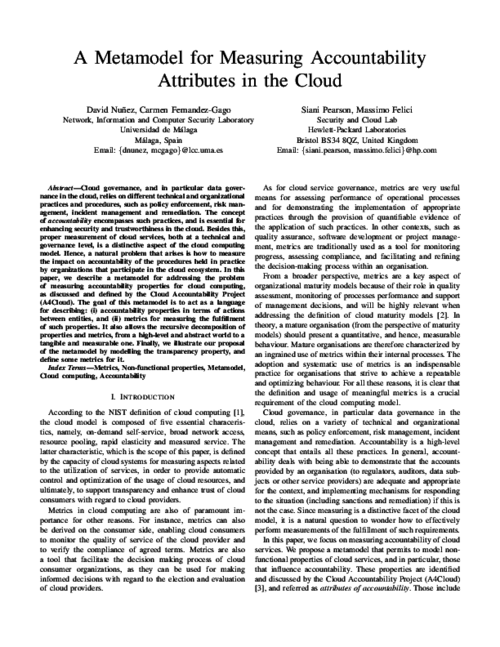
International Workshop on Quantitative Aspects in Security Assurance, 2012.
Abstract
During the last decades, a huge amount of trust and reputation models have been proposed, each of them with their own particularities and targeting different domains. While much effort has been made in defining ever-increasing complex models, little attention has been paid to abstract away the particularities of these models into a common set of easily understandable concepts. We propose a conceptual framework for computational trust models that is used for developing a component-oriented development framework that aims to assist developers during the implementation phase.
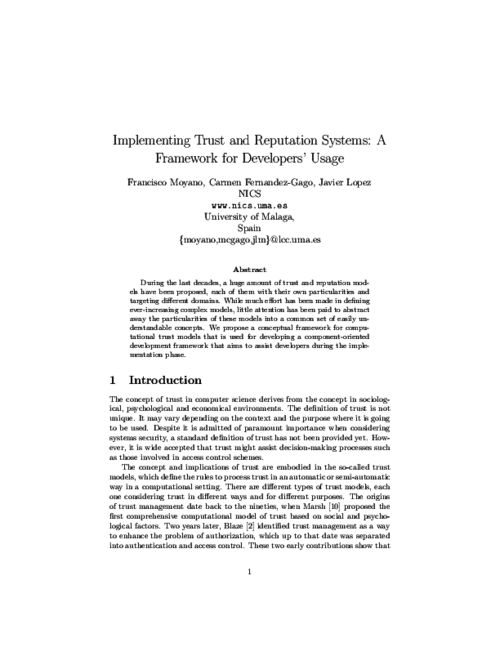
Requirements Engineering, vol. 18, issue 4, Springer London, pp. 321-341, Nov 2013. DOI
Abstract
Cloud applications entail the provision of a huge amount of heterogeneous, geographically-distributed resources managed and shared by many different stakeholders who often do not know each other beforehand. This raises numerous security concerns that, if not addressed carefully, might hinder the adoption of this promising computational model. Appropriately dealing with these threats gains special relevance in the social cloud context, where computational resources are provided by the users themselves. We argue that taking trust and reputation requirements into account can leverage security in these scenarios by incorporating the notions of trust relationships and reputation into them. For this reason, we propose a development framework onto which developers can implement trust-aware social cloud applications. Developers can also adapt the framework in order to accommodate their application-specific needs.
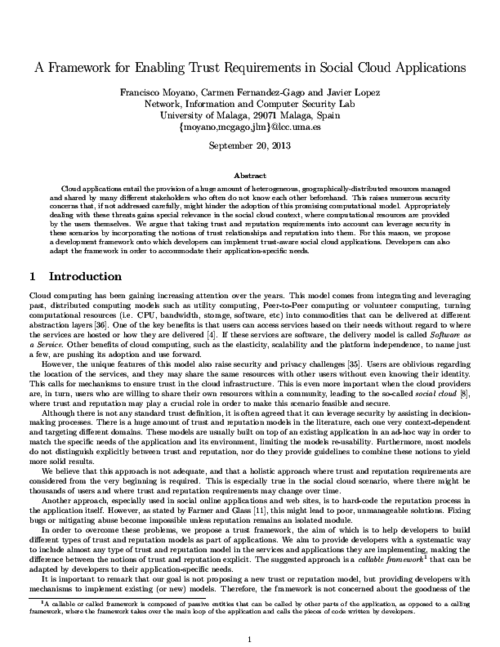
International Journal of Advanced Robotics Systems, vol. 2, SAGE Publishing, pp. 363-371, 2005. DOI
Abstract
It is a characteristic of swarm robotics that specifying overall emergent swarm behaviours in terms of the low-level behaviours of individual robots is very difficult. Yet if swarm robotics is to make the transition from the laboratory to real-world engineering realisation we need such specifications. This paper explores the use of temporal logic to formally specify, and possibly also prove, the emergent behaviours of a robotic swarm. The paper makes use of a simplified wireless connected swarm as a case study with which to illustrate the approach. Such a formal approach could be an important step toward a disciplined design methodology for swarm robotics.
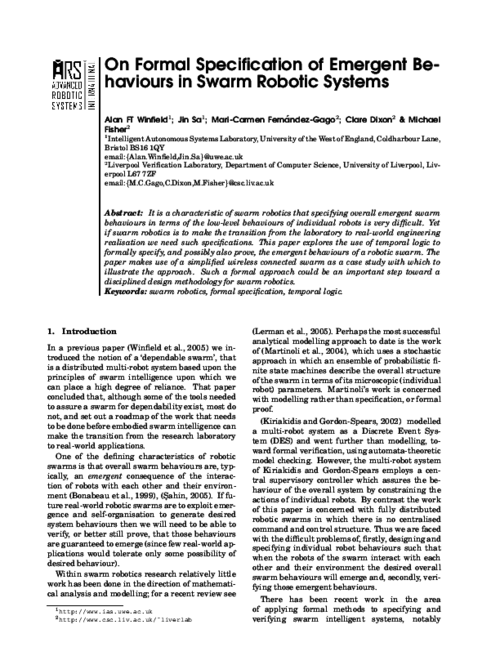
Journal of Automated Reasoning, vol. 34, Springer, pp. 295-321, 2005. DOI
Abstract
First-order temporal logic, the extension of first-order logic with operators dealing with time, is a powerful and expressive formalism with many potential applications. This expressive logic can be viewed as a framework in which to investigate problems specified in other logics. The monodic fragment of first-order temporal logic is a useful fragment that possesses good computational properties such as completeness and sometimes even decidability. Temporal logics of knowledge are useful for dealing with situations where the knowledge of agents in a system is involved. In this paper we present a translation from temporal logics of knowledge into the monodic fragment of first-order temporal logic. We can then use a theorem prover for monodic first-order temporal logic to prove properties of the translated formulas. This allows problems specified in temporal logics of knowledge to be verified automatically without needing a specialized theorem prover for temporal logics of knowledge. We present the translation, its correctness, and examples of its use.
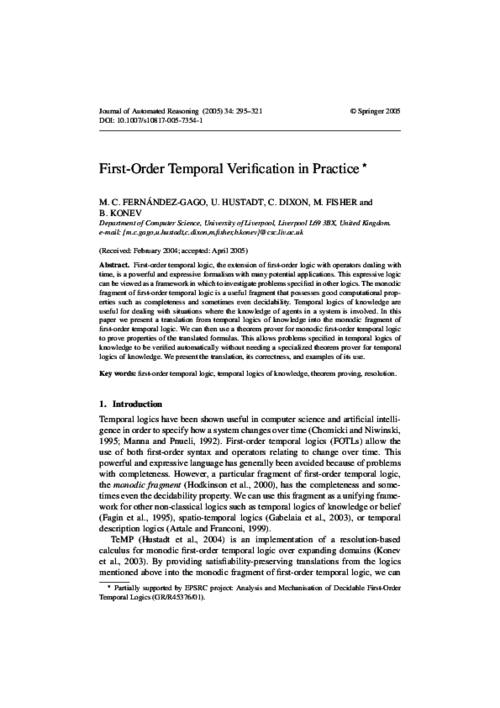
1st International Conference on Autonomic Computing and Communication Systems (Autonomics’07), ICST, October, 2007.
Abstract
Research on trust management systems for wireless sensor networks is still at a very early stage and few works have done so far. It seems that for those works which deal with the topic general features of how these systems should be are not clearly identified. In this paper we try to identify the main features that a trust management system should have and justify their importance for future developments.
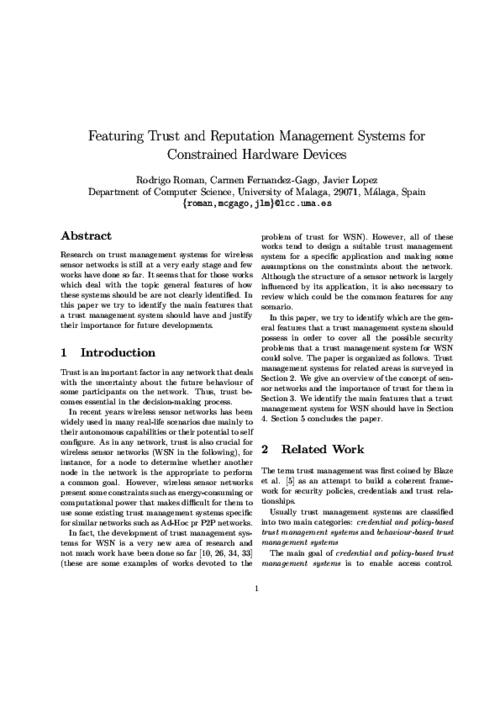
4th Workshop on Security and Trust Management (STM’08), ENTCS 224, Elsevier, pp. 3-12, 2008. DOI
Abstract
In this paper we propose a trust model, where besides considering trust and distrust, we also consider another parameter that measures the reliability on the stability of trust or distrust. The inclusion of this new parameter will allow us to use trust in a more accurate way. We consider trust is not static but dynamic and trust values can change along time. Thus, we will also take time into account, using it as a parameter of our model. There is very little work done about the inclusion of time as an influence on trust. We will show the applicability of our model in the scenario of the process of reviewing papers for a conference. Sometimes for these kind of processes the Chair of the conference should first find the suitable reviewers. He can make this selection by using our model. Once the reviewers are selected they send out their reviews to the Chair who can also use our model in order to make the final decision about acceptance of papers.
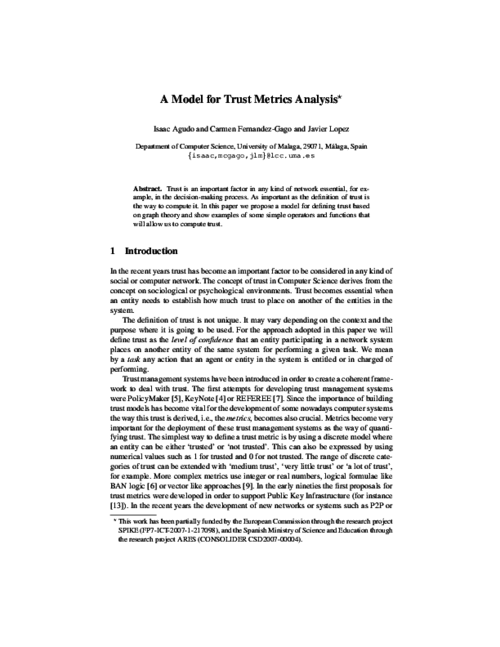
Smart Grid Security - Second International Workshop, J. Cuellar Eds., LNCS 8448, Springer, pp. 166-180, Aug, 2014. DOI
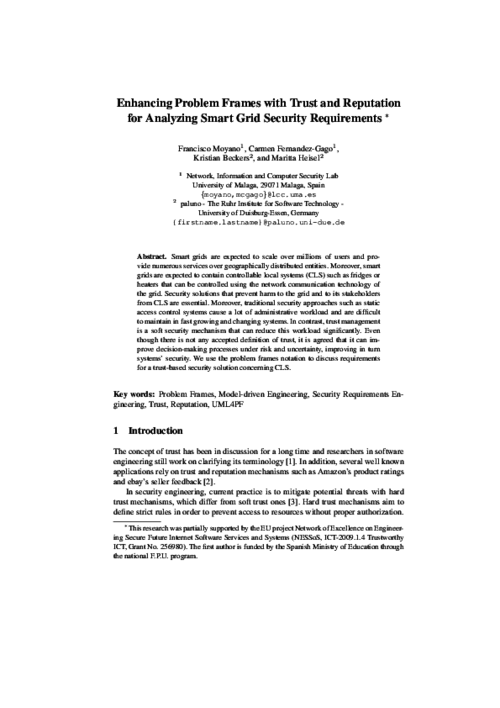
Engineering Secure Future Internet Services and Systems, vol. LNCS 8431, no. 8431, Springer, pp. 180-209, 03/2014. DOI
Abstract
The Future Internet (FI) comprises scenarios where many heterogeneous and dynamic entities must interact to provide services (e.g., sensors, mobile devices and information systems in smart city scenarios). The dynamic conditions under which FI applications must execute call for self-adaptive software to cope with unforeseeable changes in the application environment. Models@run.time is a promising model-driven approach that supports the runtime adaptation of distributed, heterogeneous systems. Yet frameworks that accommodate this paradigm have limited support to address security concerns, hindering their usage in real scenarios. We address this challenge by enhancing models@run.time with the concepts of trust and reputation. Trust improves decision-making processes under risk and uncertainty and constitutes a distributed and flexible mechanism that does not entail heavyweight administration. This chapter introduces a trust and reputation framework that is integrated into a distributed component model that implements the models@run.time paradigm, thus allowing software components to include trust in their reasoning process. The framework is illustrated in a smart grid scenario.
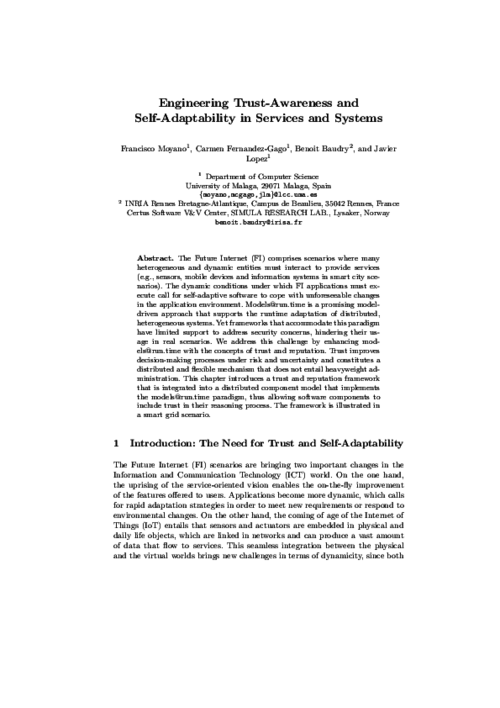
The 30th ACM/SIGAPP Symposium On Applied Computing (SAC 2015), pp. 1344-1349, 08/2015. DOI
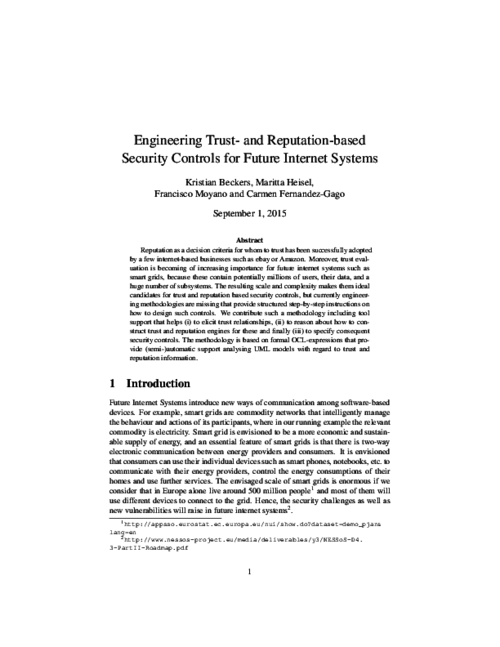
Computers & Security, vol. 62, Elsevier, pp. 149-164, 08/2016. DOI
Abstract
Cloud computing provides enormous business opportunities, but at the same time is a complex and challenging paradigm. The major concerns for users adopting the cloud are the loss of control over their data and the lack of transparency. Providing accountability to cloud systems could foster trust in the cloud and contribute toward its adoption. Assessing how accountable a cloud provider is becomes then a key issue, not only for demonstrating accountability, but to build it. To this end, we need techniques to measure the factors that influence on accountability. In this paper, we provide a methodology to elicit metrics for accountability in the cloud, which consists of three different stages. Since the nature of accountability at- tributes is very abstract and complex, in the first stage we perform a conceptual analysis of the accountability attributes in order to decompose them into concrete practices and mechanisms. Then, we analyze relevant control frameworks designed to guide the implementation of security and privacy mechanisms, and use them to identify measurable factors, related to the practices and mechanisms defined earlier. Lastly, specific metrics for these factors are derived. We also provide some strategies that we consider relevant for the empirical validation of the elicited accountability metrics.
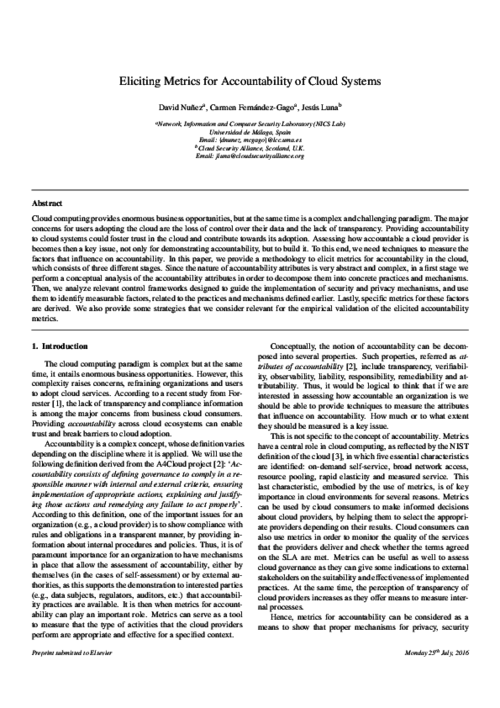
IEEE Transactions on Smart Grid, vol. 2, no. 4, IEEE, pp. 827-834, Nov 2011. DOI
Abstract
Most of energy control or SCADA (Supervisory Control and Data Acquisition) systems are very dependent on advanced technologies and on traditional security mechanisms for protecting the a system against anomalous events. Security mechanisms are not enough to be used in critical systems, since they can only detect anomalous events occurring at a certain moment in time. For this reason it becomes of paramount importance the usage of intelligent systems with capability for preventing anomalous situations and reacting against them on time. This type of systems are, for example, Early Warning Systems (EWS). In this paper, we propose an EWS based on Wireless Sensor Networks (WSNs) (under the ISA100.11a standard) and reputation for controling the network behaviour. The WSN are organized into clusters where a Cluster Head (CH) is designated. This CH will contain a Reputation Manager Module. The usability of this approach is also analyzed considering a Smart Grid scenario.} keywords = {Critical Information Infrastructures, Sensor Networks, Early Warning Systems, Reputation, SCADA Systems, Smart Grid.
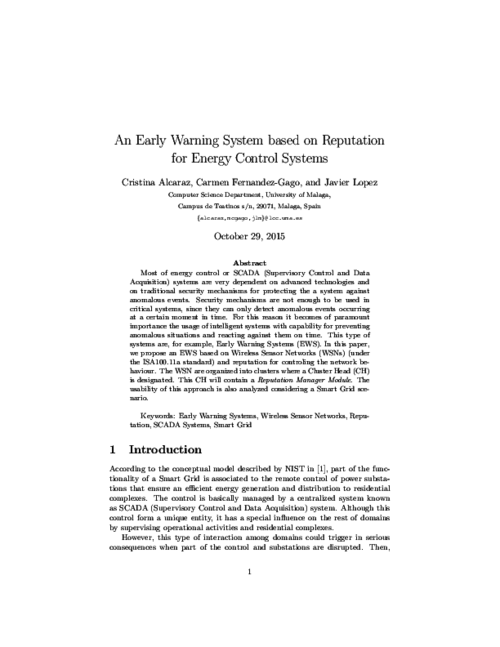
8th International Conference on Availability, Reliability and Security, IEEE, pp. 121-130, Nov 2013. DOI
Abstract
The number of insider threats hitting organizations and big enterprises is rapidly growing. Insider threats occur when trusted employees misuse their permissions on organizational assets. Since insider threats know the organization and its processes, very often they end up undetected. Therefore, there is a pressing need for organizations to adopt preventive mechanisms to defend against insider threats. In this paper, we propose a framework for insiders identification during the early requirement analysis of organizational settings and of its IT systems. The framework supports security engineers in the detection of insider threats and in the prioritization of them based on the risk they represent to the organization. To enable the automatic detection of insider threats, we extend the SI* requirement modeling language with an asset model and a trust model. The asset model allows associating security properties and sensitivity levels to assets. The trust model allows specifying the trust level that a user places in another user with respect to a given permission on an asset. The insider threats identification leverages the trust levels associated with the permissions assigned to users, as well as the sensitivity of the assets to which access is granted. We illustrate the approach based on a patient monitoring scenario.
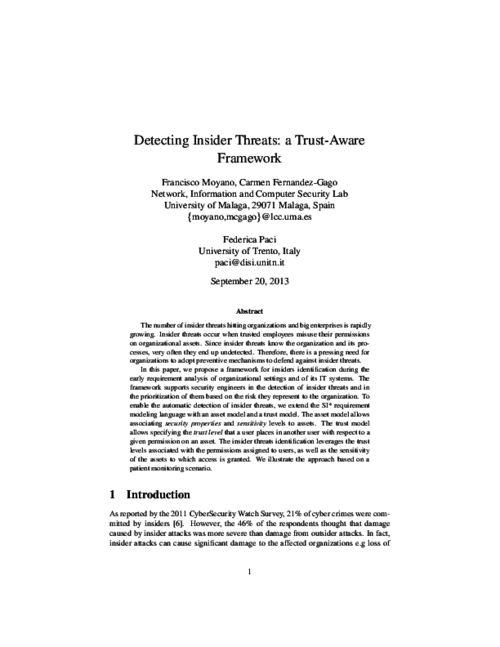
5th International Workshop on Formal Aspects in Security and Trust (FAST’08), LNCS 5491, Springer, pp. 302-315, 2008. DOI
Abstract
When delegation in real world scenarios is considered, the delegator (the entity that posses the privileges) usually passes the privileges on to the delegatee (the entity that receives the privileges) in such a way that the former looses these privileges while the delegation is effective. If we think of a physical key that opens a door, the privilege being delegated by the owner of the key is opening the door. Once the owner of the key delegates this privilege to another entity, by handing over the key, he is not able to open the door any longer. This is due to the fact that the key is not copied and handed over but handed over to the delegatee. When delegation takes place in the electronic world, the delegator usually retains also the privileges. Thus, both users have them simultaneously. This situation, which in most cases is not a problem, may be undesirable when dealing with certain kind of resources. In particular, if we think of finite resources, those in which the number of users accessing simultaneously is finite, we can not allow that a user delegating his access privilege is also granted access when the delegation if effective. In this paper we propose an approach where each user is delegated an access quota for a resource. If further delegating of the delegated quota occurs, this is subtracted from his quota. That is, when delegating, part of the quota remains with the delegator and another part goes to the delegatee. This allows a more fairly access to the resource. Moreover, we show that this approach can also be applied to any kind of resources by defining appropriate authorization policies.
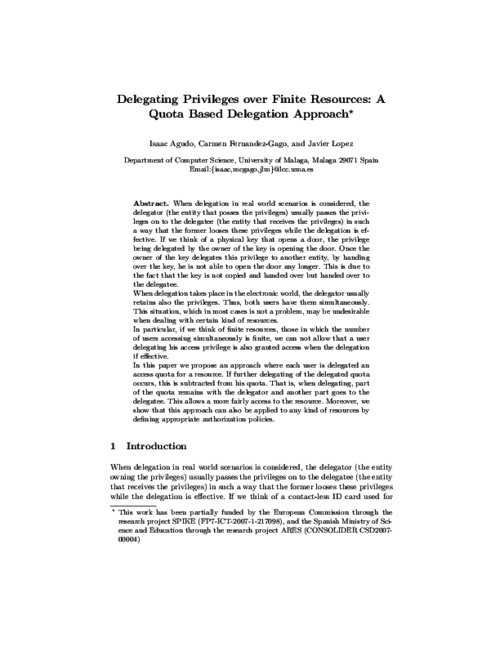
Concurrency and Computation: Practice and Experience, vol. 21, John Wiley & Sons, pp. 1389-1403, July, 2009. DOI
Abstract
Concurrent access control is an old problem in many fields in Computer Science. It has been solved in many languages and systems, using mechanisms like monitors or priority queues. Nowadays computers implement multi-core capabilities. This means that they are virtually capable of execution of processes in parallel. This requires new techniques and open new issues in the field of concurrent access control. Moreover, most operating systems are multi-user; thus, we have to focus on a multi-processor multi-user scenario. Trust becomes a paramount aspect when building distributed applications; the same applies on a lower scale in modern computers. We propose the use of a trust graph that keeps record of the trust relationships of the system and helps in deciding on concurrent access requests. The information encoded in the graph will be used both in order to decide on the access requests and to order granted requests in terms of their associated trust level
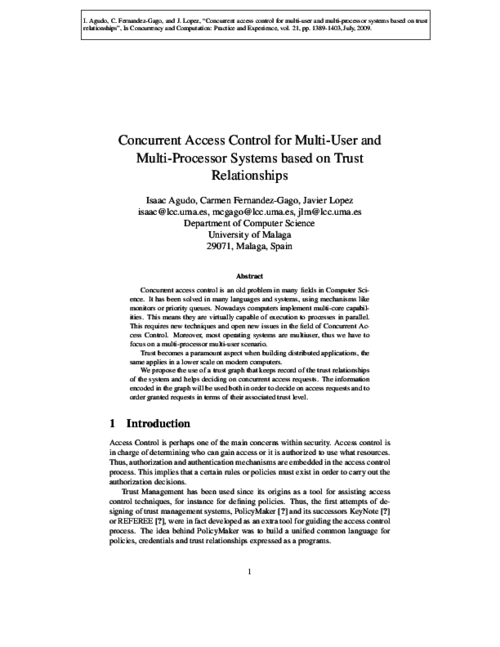
9th International Conference on Trust, Privacy & Security in Digital Business (TrustBus 2012), S. Fischer-Hübner, S. Katsikas, and G. Quirchmayr Eds., LNCS 7449, Springer Verlag, pp. 93-104, Sep 2012. DOI
Abstract
During the last twenty years, a huge amount of trust and reputation models have been proposed, each of them with their own particularities and targeting different domains. While much effort has been made in defining ever-increasing complex models, little attention has been paid to abstract away the particularities of these models into a common set of easily understandable concepts. We propose a conceptual framework for computational trust models that will be used for analyzing their features and for comparing heterogeneous and relevant trust models.
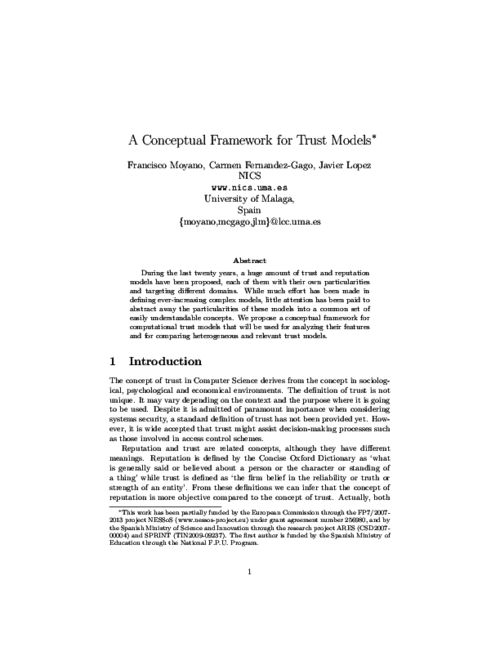
Computer Standards & Interfaces, Special Issue on Security in Information Systems, vol. 36, issue 4, Elsevier, pp. 792-800, 2014. DOI
Abstract
Trust is an essential feature of any system where entities have to collaborate among them. Trust can assist entities making decisions about what is the best entity for establishing a certain collaboration. It would be desirable to simulate behaviour of users as in social environments where they tend to establish relationships or to trust users who have common interests or share some of their opinions, i.e., users who are similar to them to some extent. Thus, in this paper we first introduce the concept of context similarity among entities and from it we derive a similarity network which can be seen as a graph. Based on this similarity network we dene a trust model that allows us also to establish trust along a path of entities. A possible applications of our model are proximity-based trust establishment. We validate our model in this scenario.
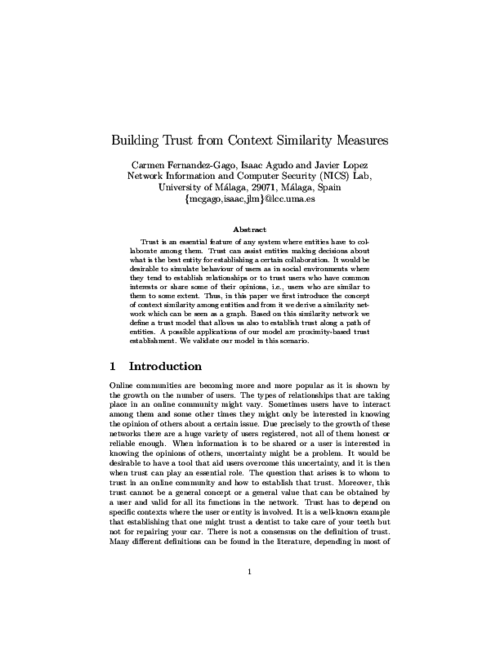
8th International Workshop on Security and Trust Management (STM 2012), A. Jøsang, P. Samarati, and M. Petrocchi Eds., LNCS 7783, Springer, pp. 113-128, 2013. DOI
Abstract
During the last years, many trust and reputation models have been proposed, each one targeting different contexts and purposes, and with their own particularities. While most contributions focus on defining ever-increasing complex models, little attention has been paid to the process of building these models inside applications during their implementation. The result is that models have traditionally considered as ad-hoc and after-the-fact solutions that do not always fit with the design of the application. To overcome this, we propose an object-oriented development framework onto which it is possible to build applications that require functionalities provided by trust and reputation models. The framework is extensible and flexible enough to allow implementing an important variety of trust models. This paper presents the framework, describes its main components, and gives examples on how to use it in order to implement three different trust models.
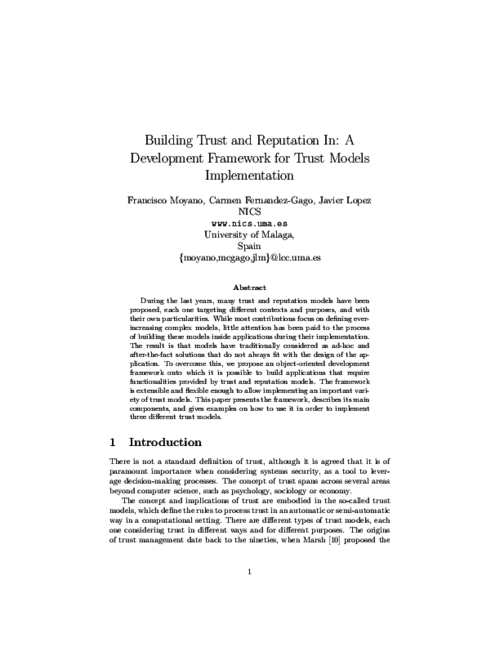
The 20th World Conference on Information Security Applications: WISA-Workshop 2019, Springer, 2019.
Abstract
In recent times, smart home devices like Amazon Echo and Google Home have reached mainstream popularity. These devices are intrinsically intrusive, being able to access user’s personal information. There are growing concerns about indiscriminate data collection and invasion of user privacy in smart home devices. Improper trust assumptions and security controls can lead to unauthorized access of the devices, which can have severe consequences (i.e. safety risks). In this paper, we analysed the behaviour of smart home devices with respect to trust relationships. We set up a smart home environment to evaluate how trust is built and managed. Then, we performed a number of interaction tests with different types of users (i.e. owner, guests). As a result, we were able to assess the effectiveness of the provided security controls and identify some relevant security issues. To address them, we defined a trust model and proposed a solution based on it for securing smart home devices.

25th Conference on Artificial Intelligence (KI’02), LNAI 2479, Springer, pp. 235-249, September, 2002.
Abstract
Clausal temporal resolution is characterised by a translation of the formulae whose satisfiability is to be established to a normal form, step resolution (similar to classical resolution) on formulae occurring at the same states and temporal resolution between formulae describing properties over a longer period. The most complex part of the method occurs in searching for candidates for the temporal resolution operation, something that may need to be carried out several times. In this paper we consider a new technique for finding the candidates for the temporal resolution operation. Although related to the previously developed external search procedure, this new approach not only allows the temporal resolution operation to be carried out at any moment, but also simplifies any subsequent search required for similar temporal formulae. Finally, in contrast with previous approaches, this search can be seen as an inherent part of the resolution process, rather than an external procedure that is only called in certain situations.} year = {2002
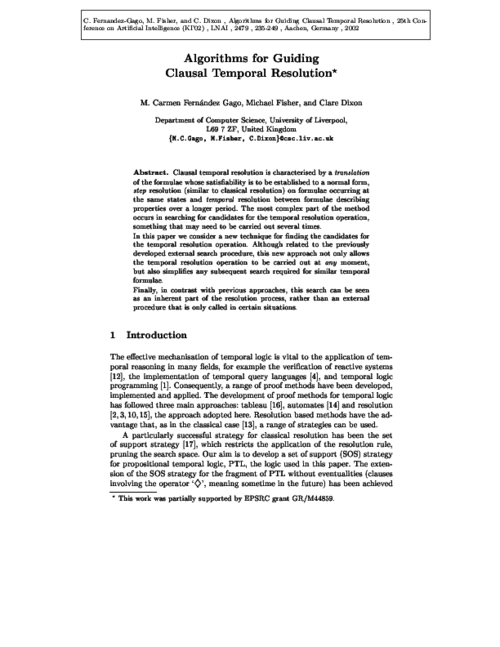
4th International Workshop on Strategies in Automated Deduction (STRATEGIES’01), June, 2001.
Abstract
The clausal resolution method developed for discrete temporal log- ics involves translation to a normal form, classical resolution on formulae within states (termed step resolution) and temporal resolution between states. Step res- olution may generate an unnecessarily large set of clauses. In addition, the most expensive part of the method is the application of the temporal resolution oper- ation. In this paper we develop an algorithm to guide the search for the set of clauses needed for the application of temporal resolution. The algorithm is based on the outputs of a refined temporal resolution rule which allows us to generate temporal resolvents earlier within the process. In particular, this can also help us to avoid unnecessary step resolution and focus search for the most relevant clauses.
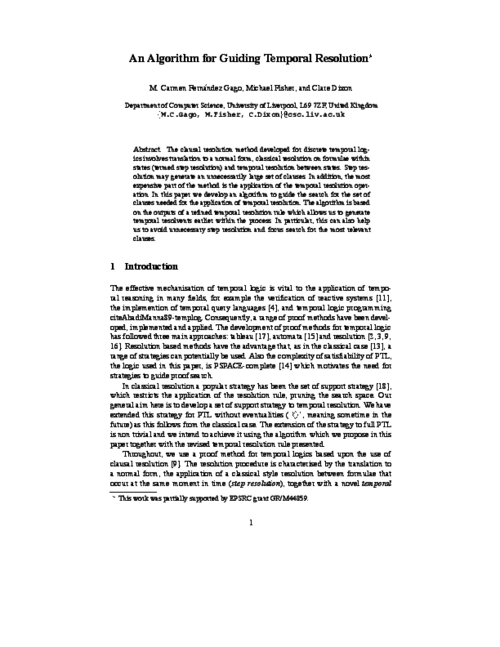
6th International Conference on Trust, Privacy and Security in Digital Business (TrustBus’09), Springer-Verlag, pp. 86-94, September, 2009. DOI
Abstract
SCADA systems represent a challenging scenario where the management of critical alarms is crucial. Their response to these alarms should be efficient and fast in order to mitigate or contain undesired effects. This work presents a mechanism, the Adaptive Assignment Manager (AAM) that will aid to react to incidences in a more efficient way by dynamically assigning alarms to the most suitable human operator. The mechanism uses various inputs for identifying the operators such as their availability, workload and reputation. In fact, we also define a reputation component that stores the reputation of the human operators and uses feedback from past experiences.
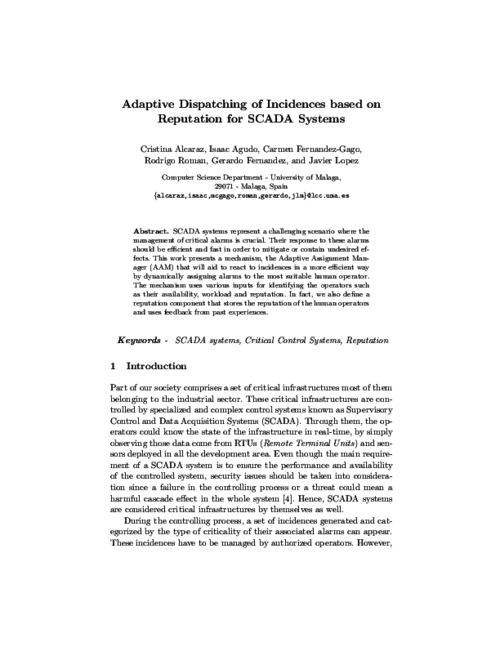
|
"Accountability and Security in the Cloud", Lecture Notes in Computer Science, vol. 8937, 2015. 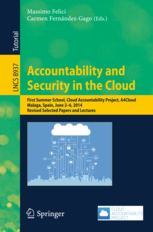 |  |
IFIP Sumer School 2015 on Privacy and Identity Management. Time for a Revolution?, vol. 476, AICT Series, Springer, pp. 61-78, 07/2016.
